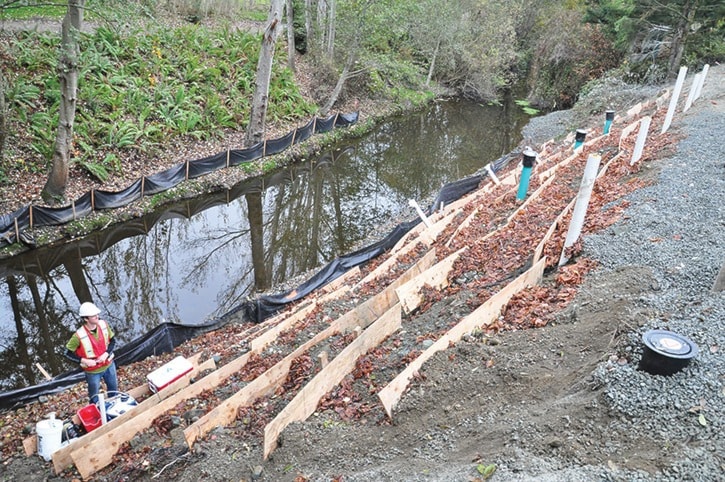What was an access point for excavators and heavy machinery is now a slope of ferns and greenery. It’s becoming difficult to tell Colquitz creek spent two months as a construction zone.
The Colquitz remediation project is being heralded as a success by creek stewards and B.C. Hydro. The utility orchestrated a project to dig out some 850 tons of stream bank over August and September after a transmission line under Interurban Road was found to be leaking mineral oil.
“The challenge for us was getting it done within the fish window. It’s great to see stocks are returning to the creek,” said Ted Olynyk with B.C. Hydro. “It was planned to minimize the impact (on the creek). We removed the soil, stabilized the bank, removed invasive species, and dealt with a hazard tree. We’re happy with the result.”
Crews will be planting trees on the excavated bank this week to stabilize the soil. That section is peppered with monitor wells to check for any residual oil.
“So far there is no more oil,” Olynyk said. “We will be monitoring the area and the creek until the cable is replaced,” which will be “a number of years.”
Mysterious oily sheens had appeared in that section of the creek (opposite Columbine Way) for months last year, and for possibly much longer according to creek stewards, and without an apparent source.
Colquitz has also been hit with at least eight spills from leaking home heating oil tanks in the past two years.
Chris Bos, president of the Colquitz Salmonid Stewardship and Education Society, said volunteers haven’t seen a return of oil on the water during what is a banner year for the salmon run.
Last Saturday saw the biggest single day return of fish since they started counting in 2001, and they’re up to about 570 coho as of late last week.
“Oil was leaking for some time and infiltrated into the soil. (B.C. Hydro) realized stopping the leak wasn’t the answer,” Bos said. “They shored up the road, removed soil, to their credit they did a good job. They put resources into it to make sure it was done properly.”
“This project reminds us of the benefit of working closely with local government and local stakeholders,” Olynyk said. “They helped us a lot. It’s important to have people who know what they’re doing”
Last year Colquitz creek had a meager salmon run, but Craigflower creek, which also empties into Portage inlet, saw more than 1,300 returning salmon in its most successful year in memory.
“We knew a lot of fish came into Portage inlet that year, we had expected to see a good return for Colquitz,” Bos said. “But I’m guessing it was like a choice between going into a room full of smoke and a room full of fresh air. What would you chose?”
The final phase of remediation is the planting of “waddle fences” next week along the excavated slope, a series of terraced tree cuttings that will stabilize the soil and cover the area in greenery over time.
Whether the excavation has an impact on salmon may be difficult to know, but Bos said biologists confirmed fish were in the creek before and after the work.
“Despite our best efforts, Colquitz doing well,” Bos quipped.
“We’re lucky to have a gem like this in the Victoria area. There’s a lot of urbanization between Portage (inlet) and the mouth of Beaver Lake, a lot of housing and farming. It’s quite urbanized but its a productive creek.”
editor@saanichnews.com
